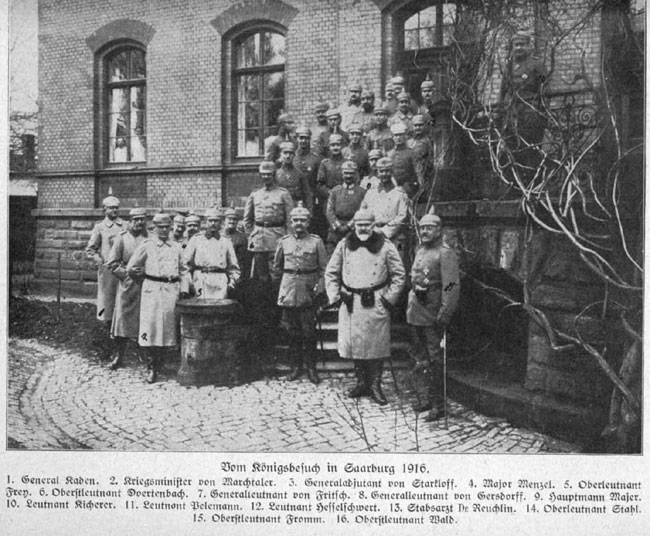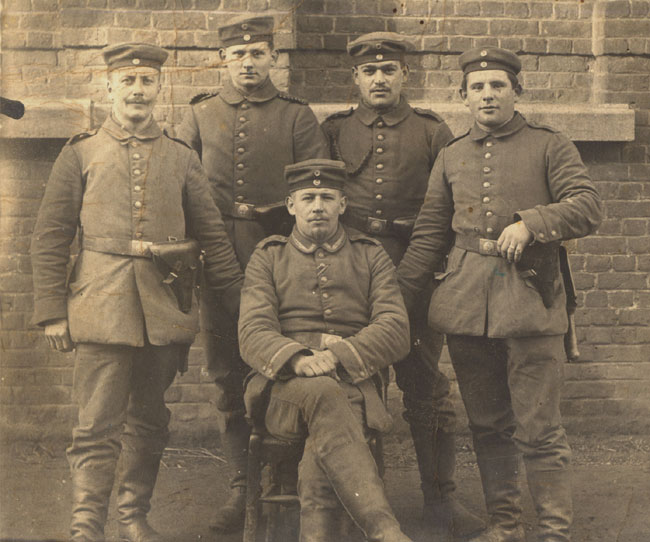Biographical note: Generalmajor Richard Kaden
Richard Kaden was born on 7th March 1862 in Dresden, evidently into a military family (since his younger brother Alfred also became a senior Saxon officer). Richard joined Kgl. Sächs. 2. Grenadier-Regiment Kaiser Wilhelm, König von Preußen Nr. 101 (GR 101) as an Avantageur on 1st December 1879 and was commissioned as a Leutnant in 1881. His subsequent career included posts with several Saxon infantry regiments, the general staff and the Kriegsministerium in Dresden. On 23rd September 1911 he was promoted to Oberst and given command of Kgl. Sächs. 11. Infanterie-Regiment Nr. 139 (IR 139) in Döbeln. Kaden would always maintain a special affection for this regiment, but would never command it in battle due to his elevation to the Generalität (the class of general officers) on 20th April 1914.
Now holding the rank of Generalmajor and command of 48. Infanterie-Brigade (IR 106 and 107) within 24. Infanterie-Division, Kaden took part in the invasion and the First Battle of the Marne that summer. When the bulk of XIX. Armeekorps were sent north to attack Lille, his brigade initially remained on the Champagne front in reserve. Rushed north on 22nd October 1914 during the First Battle of Ypres, IR 106 and 107 were thrown into the XIX.AK front at Ploegsteert Wood and La Houssoie respectively.
They were still there at Christmas, and 'Fighting the Kaiser's War' includes his remarkable and revealing description of the truce (to our knowledge, he is the highest ranking officer of the corps to have left a surviving account of this remarkable event). Please refer to my Christmas Truce article for further information.
In early 1915 the divisions of XIX.AK were among those chosen for what English-speaking authors have termed 'triangularisation' - reduction from four infantry regiments each (organised into two brigades) down to three (organised into a single brigade). Alongside the ongoing reduction of field artillery batteries from six to four guns, and a still greater reduction in divisional cavalry, this measure allowed the rapid creation of a whole wave of new divisions. The practical result for Generalmajor Kaden was that on 4th March 1915, he and his staff were suddenly ordered to be in Cambrai two days later. Within a week they had been joined by their troops - IR 106, IR 107 and Württemberg Reserve-Infanterie-Regiment 120 (from the 'triangularisation' of 26. Reserve-Division). Kaden's command was henceforth 116. Infanterie-Brigade of 58. Infanterie-Division, the second and arguably the most successful of the three mixed Saxon / Württemberg divisions.
Under Kaden's command the brigade fought with distinction at Vimy Ridge in May-June and in the victorious German campaign in the east from July to October 1915. His last campaign was Verdun in March–April 1916. For three hellish weeks, the brigade struggled to hold and advance the front through the blockhouse-studded Caillettewald (Bois de la Caillette) towards Fleury, in the teeth of the heaviest artillery fire the French Army could muster and a relentless series of counter-attacks. According to Sachsen in großer Zeit this ordeal cost the division an estimated total of 507 dead (including nineteen officers), 2,391 wounded (including fifty-five officers) and 165 missing (including one officer); a further 2,648 were reported sick. On the very first day, Kaden's brigade HQ dugout was partially demolished by a direct hit from heavy artillery, killing or maiming some of his closest colleagues. He was thus in no mood to be diplomatic in criticising the use made of his brigade (or the wider conduct of the battle), and evidently made some enemies among the Falkenhayn faction, who had staked everything on the Verdun campaign.

Writing in 1933 Kaden declined to name his opponents, but made it clear that he was 'pushed' out of his post. Privately informed that he could not expect to become a divisional commander, he took the implied offer of an honourable retirement and tendered his resignation. This was sweetened on 27th April 1916 by the award of the Komturkreuz 2. Klasse of the Militär-St.Heinrichs-Orden, with a citation praising his leadership of the brigade in battle under exceptionally difficult conditions.
On the semi-retired (zur Disposition) list from 11th August, he was given the home-front command of Stellvertretende 89. Infanterie-Brigade in Zwickau in November 1916. On 17 June 1918 he was charakterisiert (granted an honorary promotion) to the rank of Generalleutnant. He finally left what was now the Reichswehr of the Weimar Republic in 1920 after over forty years of military service, and died in 1948.
All three of Kaden's sons fought as Saxon officers during the war, and only one survived. Leutnant Hellmuth Kaden was cut down by French machine-guns at La Salle on 7 September 1914, while serving as adjutant and acting battery commander with the Mobile Ersatz-Abteilung / Feldartillerie-Regiment 77 (a provisional battalion-sized unit belonging to 19.Ersatz-Division). In a particularly harsh blow Leutnant der Reserve Hans Kaden was serving with his father's beloved IR 139 when he too was killed in action at L'Epinette in June 1916. The fate of the general's third son, Leutnant Gert Kaden, was not so tragic but nevertheless a source of great anxiety for his family. In peacetime a subaltern with the MG-Kompagnie of IR 103, Gert was serving in the field with Ersatz-Infanterie-Regiment 23 (again, with 19. Ersatz-Division) when in late 1915 he tried to arrange a transfer to the cavalry – evidently without consulting his father. For unknown reasons, this highly unusual request resulted in a protracted and complex case before the military courts, and Gert's eventual discharge from the Royal Saxon officers' corps.
Our primary source for the selection of diary entries in Fighting the Kaiser's War (covering the First Battle of Ypres, Christmas Truce and formation of 58. Inf. Div.) is an original hand-annotated typescript of Generalmajor Kaden's journal. Occasional comments suggest later revision with the benefit of hindsight, the extent of which can only be guessed at. Portions of the journal were included in Kaden's published autobiography In der Alten Armee (1933), but as a rule stripped of all references to family matters and (potentially libellous) criticisms of named officers.
- << Prev
- Next






